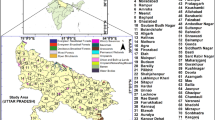Abstract
A functional form of crop spectral profile suggested by Badhwar was applied to district-wise wheat Normalised Difference Vegetation Index (NDVI) values relatively normalised by Pseudo-Invariant Feature (urban and built-up) NDVI values, derived from Wide Field Sensor (WiFS) onboard Indian Remote Sensing Satellites (IRS) for 17 dates during 1999–2000 rabi season. The goodness of overall profile fitting and the three basic parameters i.e., crop emergence date (To), and crop specific parameters (a and P) was found to be statistically significant. While a corresponds to profile progressive growth rate, β corresponds to profile decay rate. A comparison with earlier studies in Punjab using NOAA-AVHRR indicated improvement in relation between peak NDVI and wheat yield. The estimated time of spectral emergence and profile-derived peak NDVI follow the observed behaviour of shortened crop pre-anthesis period with delayed sowing.
Similar content being viewed by others
References
Badhwar, G.D. (1980). Crop emergence date determination from spectral data.Photogramm. Engg. & Remote Sensing 46(3): 369–377.
Badhwar, G.D. (1984). Use of Landsat-derived profile features for spring small-grain classification.Int. J. Remote Sensing,5(5): 783–797.
Badhwar, G.D., Carnes, J.G. and Austin, W.W. (1982). Use of Landsat-derived temporal profiles for cornsoybean feature extraction and classification.Remote Sensing Env.,12: 57–79.
Chavez, P.S. Jr. (1996). Image based atmospheric correction: Revisited and improved.Photogramm. Engg. Remote Sensing,62: 1025–1036.
Dadhwal, V.K., Sehgal, V.K., Singh, R.P. and Rajat, D.R. (2003). Wheat yield modelling using Satellite Remote Sensing with weather data: Recent Indian experience.Mausam,54: 253–262.
Dubey, R.P., Ajwani, N.D. and Navalgund, R.R. (1991). Relation of wheat yield with parameters derived from a spectral growth profile.J. Indian Soc. Remote Sensing,19(1): 27–44.
Handerson, K.E. and Badhwar, G.D. (1984). An initial model for estimating soybean development stages from spectral data.Remote Sensing Env.,14: 55–63.
Hundal, S.S. and Kaur, P. (1997). Application of the CERES-Wheat to yield predictions in the irrigated plains of the Indian Punjab.J. of Agric. Sci. (Cambridge),129: 13–18.
Joseph, G., Iyenger, V.S., Ratan, Ram, Nagachenchaiah, K., Kiran Kumar, A.S., Aradhye, B.V., Gupta, K.K. and Samudraiah, D.R.M. (1996). Cameras for Indian remote sensing satellites IRS-1C.Curr. Sci.,70: 510–515.
Kalubarme, M.H., Potdar, M.B., Manjunath, K.R., Mahey, R.K. and Sidhu, S.S. (1997). Spectral wheat yield modelling based on growth profile parameters derived from NOAA-11 AVHRR data. Scientific Note: RSAM/SAC/CAPE-II/SN/69/97, Space Applications Centre (ISRO), Ahmedabad, India, 26p.
NDC (1997). IRS-ID data users handbook (Hyderabad, India: National Remote Sensing Agency).
Norusis, M.J. (1994). SPSS for Windows Base System User’s Guide, Release 6.0. SPSS Inc, 444 North Michigan Avenue, Chicago, IL 60611, U.S.A., p.828.
Odenweller, J.B. and Johnson, K.I. (1984). Crop identification using Landsat temporal-spectral profiles.Remote Sensing Env.,14: 39–54.
Oza, M.P., Bhagia. N., Dutta, S., Patel, J.H. and Dadhwal, V.K. (1996). National wheat acreage estimation for 1995–96 using multi-date IRS-1C WiFS data.J. Indian Soc. Remote Sensing,24(4): 243–254.
Oza, M.R., Rajak, D.R., Bhagia, N., Nain, A. and Dadhwal, V.K. (2000). National wheat production forecasting using multi-date WiFS and meteorological data for 1999–2000 season. Scientific Note:RSAM/SAC/ FASAL-TD/SN/09/2000, Space Applications Centre (ISRO), Ahmedabad, India, 150p.
Pandya, M.R., Dadhwal, V.K. and Navalgund, R.R. (2000). Effect of WiFS viewing geometry on crop reflectance: a simulation study using SAIL model.Int. J. Remote Sensing,21: 1931–1938.
Potdar, M.B. (1993). Sorghum yield modelling based on crop growth parameters determined from visible and near-IR channel NOAA-AVHRR data.Int J. Remote Sensing,14: 895–905.
Rajak, D.R., Oza, M.P., Bhagia, N. and Dadhwal, V.K. (2002). Monitoring Cropping pattern changes using multi-temporal WiFS data.Geocarto International 17: 53-.
Saini, A.D., Dadhwal, V.K., Phadnawis, B.N. and Nanda, R. (1986). Influence of sowing dates on pre-anthesis phenology in wheat.Indian J. Agric. Sci.,56(7): 503–511.
Taylor, J.C., D’souza, G., Coleman, V.R. and Hindley, D. (1993). Vegetation conditions and yield indicators in England and Wales. Summary report: Contract No.-3441-88-08 ED ISPGB, Silsoe College, Silsoe, Bedferd. 26p.
Teillet, P.M., Staenz, K. and Williams, D.J. (1994). Effects of spectral and spatial resolutions on NDVI. Proceedings of the Second International Symposium on Spectral Sensing Research (ISSSR’94), San Diego, California, pp. 365–374.
Author information
Authors and Affiliations
Corresponding author
Additional information
Special Section on “Modeling for Remote Sensing Applications in Agriculture”
About this article
Cite this article
Rajak, D.R., Oza, M.P., Bhagiaand, N. et al. Spectral wheat growth profile in Punjab using IRS WiFS data. J Indian Soc Remote Sens 33, 345–352 (2005). https://doi.org/10.1007/BF02990055
Revised:
Accepted:
Issue Date:
DOI: https://doi.org/10.1007/BF02990055




